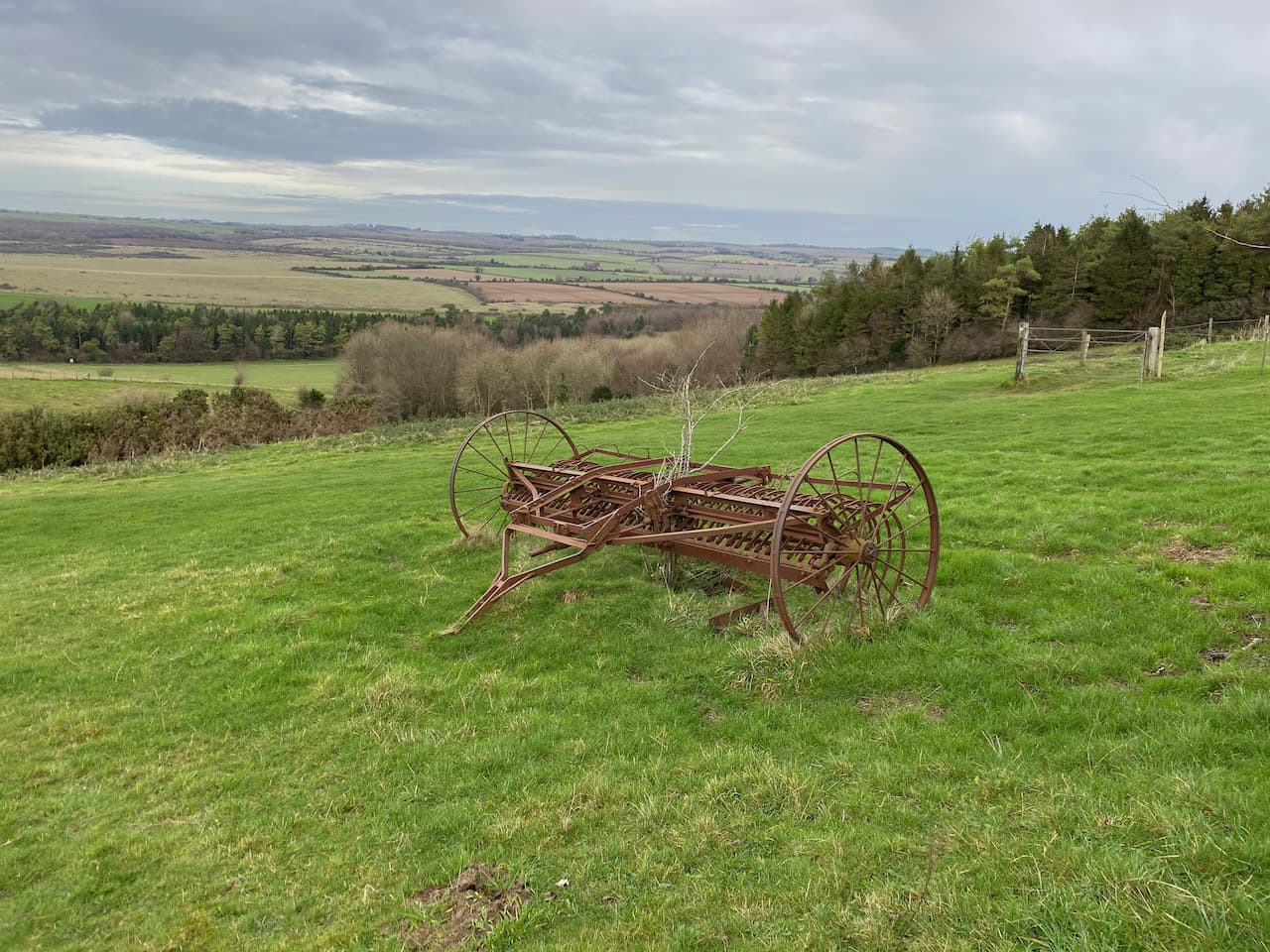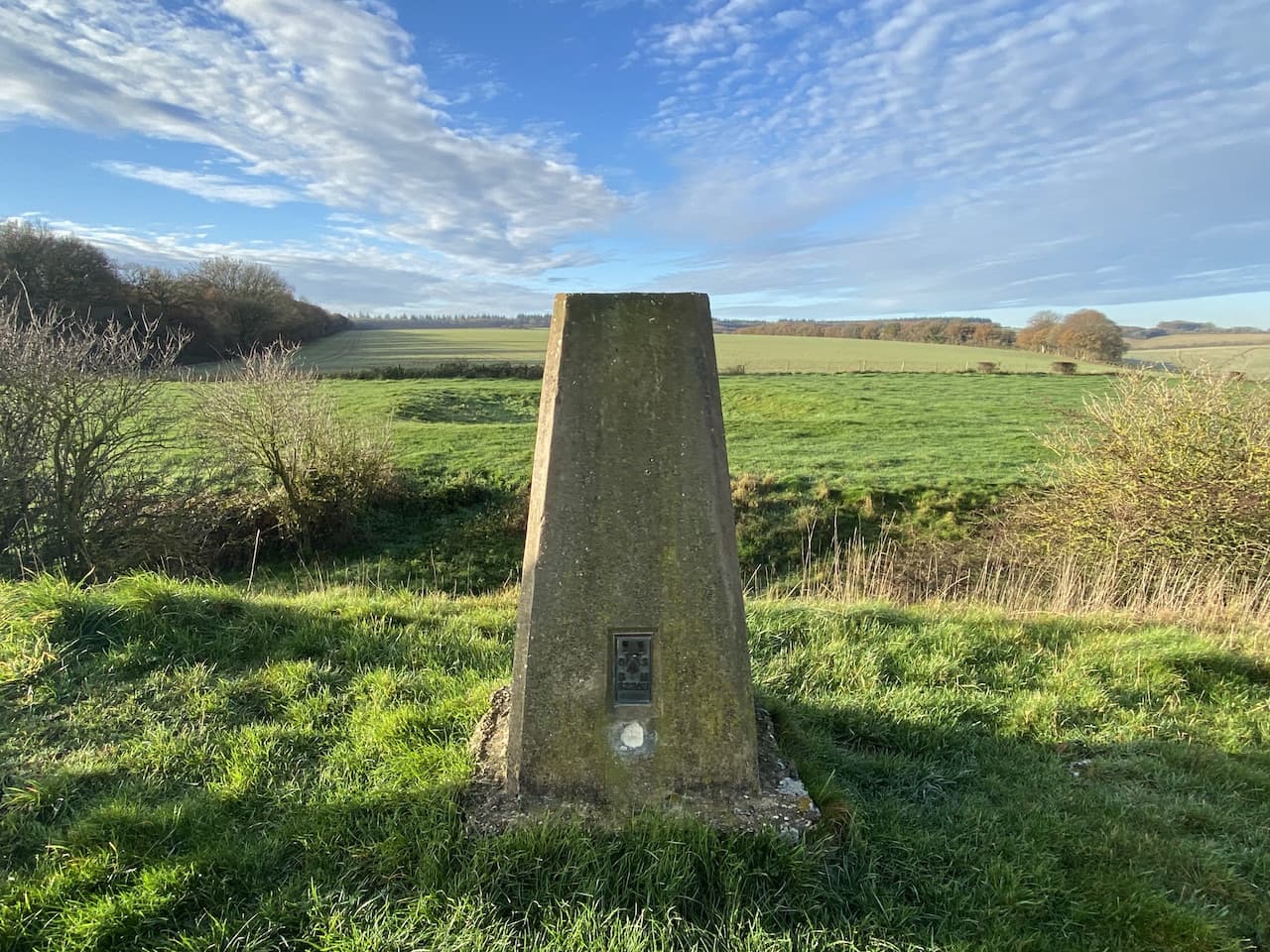Today Lynnie and are walking with our friends Wendy and Gary who we have known since they moved into the village just over a year ago. In normal circumstances I am sure we would have done a fair bit of socialising with them, but this year has been anything but normal. So apart from the occasional drink in the garden during the summer and a weekly videocall call we have not seen a lot of them. So it will be good to get out for a few hours and have a chat and try to put the world to rights.
Even though we live in the same village we travel separately to the car park on Martin Down Nature Reserve besides the A354. The weather forecast suggested there would be early morning rain, but a good chance the rest of the day would be dry and chilly. So arriving at the car park we layer up and boots on we head off.
We start from the southern end of the car park, passing a metal barrier beside some information boards. Initially the path heads through shrub, but then opens out onto the vast expanse of the nature reserve, there are over 850 acres of protected land here providing a haven for flora and fauna.

We follow the track towards the dominant rifle range butt in front of us. This area of the downs was used as a military rifle range up until the 1950’s and evidence of this is strewn across it. Before reaching the butt we take a path on the right to head across towards the Bokerley Dyke. This ditch is thought to have been built during the iron age and fortified in the 5th century. It runs for around 3.5 miles and is an impressive structure.
At the dyke we pass through to reach the fence-line of a field. Entering the field we take a footpath on the right and continue along the edge of the field with the fence to our right. The path follows around the edge of the field and we are soon heading south with a hedge line on our right.
At a junction of paths we continue straight on to reach a gate besides a crossing of paths. Here we continue along a hedge lined path still heading south towards Pentridge.

As the path reaches farm buildings it becomes a tarmac lane, Earthpits Lane, and we stay with this to walk into the village. At a sign for the church we turn right and wander up to visit the fine church of St Rumbold which apparently was rebuilt in 1855 in a 14th century style.

From the church we head back to Earthpits Lane and turn right for thirty yards to take a footpath on the left leading up a driveway before heading left across grass to a narrow path besides a fence. It is a gradual ascent to a stile leading into a pasture field. The path continues by the fence line and then as the fence turns to the right we continue straight on towards a stile. From here there are cracking views.

After crossing the stile we continue up Penbury Knoll and visit the Ordnance Survey trig pillar. I have visited this trig on a number of occasions but it is always worth a re-visit.

From the trig we head north east on a track across the access land. This track follows a fence to our right and we stay with it as the fence turns to the north. At an abandoned old hay rake we turn to the right and go through a gate.

We now follow a path along the edge of an arable field and then pass Blagdon Plantation. On reaching a track we turn right and then take the second footpath on the left to head along the side of attractive woodland.

The footpath reaches Martin Down and crosses the Bokerley Ditch.

Now we follow a path that runs besides a Grim’s Ditch. This is a common name for earthworks of this type which are found across chalk downland in southern England. Their purpose is unclear, too small to act as military defences it is thought that they marked territorial boundaries in the Iron Age.
We follow the ditch to reach a footpath where we turn left and head north along a track, this starts to descend with views towards the village of Martin in front of us.

We stay with the track as it leads to the edge of Martin Down and then continue along a hedge lined track leading towards Martin. In the village we turn left and walk along the road, Martin Drove End, until we reach a sign towards the church. Here we turn and wander up to see if we can locate the Ordnance Survey benchmark on All Saints Church.

Apparently parts of this church date back to 12th century, with the tower being built in the 13th century and then late in the 18th century a spire was added.

From the church we head back to Martin Drove End and turn right soon reaching a village green with an old pump above a covered well.

Also on the Green there is a millennium cross showing it is 37.5 miles to Glastonbury. Apparently the significance of this is that back in 945 Edmund, King of Mercia bestowed the Damerham and Martin Estate to his wife Ethelfled on the condition that she should leave it to the “ancient church of the blessed Mary in the monastery of Glastonberi”, the Abbot of Glastonbury held a manor which included the village for many centuries. Close to the millennium stone is the base of the old market cross the history of which appears hard to determine. But it is thought to date from the 5th century.

From the green we head west along Sillens Lane to leave the village. This road leads to a car park on the edge of Martin Down. Here we keep heading west across the downs until we reach a junction of paths besides a Grim’s Ditch. Here we follow a clear track heading northwest towards the rifle butts.

After passing the rifle butt we continue along the track to reach our starting point in the car park. Our walk has covered almost eight miles. The weather has been fine and not as cold as forecast and it has been great to get out and catch up after the recent Covid-19 lockdown.
You can view this 8 mile walk on OS Maps and download the GPX File Here
To follow this walk you will need Ordnance Survey Explorer Map OL130
4th December 2020
© Two Dogs and an Awning (2020)
All information on this site is provided free of charge and in good faith and no liability is accepted in respect of damage, loss or injury which might result from it. To the best of my knowledge the routes are entirely on public rights of way or within areas that are open for public access.
Walking can be hazardous and is done entirely at your own risk. It is your responsibility to check your route and navigate using a map and compass.
































